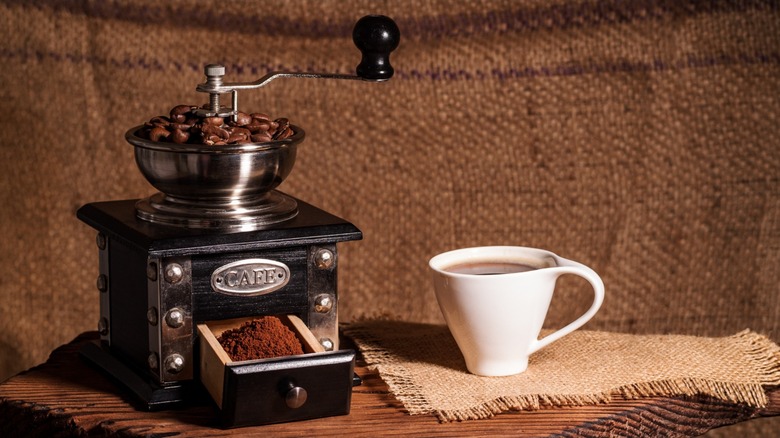This Retro Coffee Grinder Needs To Make A Comeback In Modern Kitchens
We may receive a commission on purchases made from links.
Looking back at history, it becomes patently obvious that our forefathers were, in many ways, just like us. They may not have had the science (or the instant coffee) to make foamy dalgona coffee, but they definitely appreciated a cup of joe. According to legend, the first man to discover the energizing properties of coffee berries was an Ethiopian goat-herder named Kaldi. In the 13th century, Arabian Muslims reportedly depended on coffee to power long prayer sessions. And, in 18th-century America, long before the first Starbucks handcrafted drinks, patriotic colonists turned to coffee instead of tea as an act of defiance against British imports and taxes.
How did those early Americans drink their coffee? Well, after roasting the beans, they ground them laboriously with a mortar and pestle (like this one!), which really turned a cuppa into quite the workout. By 1789, however, ingenuity led to a better way. Thomas Bruff, who was also Thomas Jefferson's dentist, invented a coffee mill that was mounted on the wall and cranked to grind large amounts of roasted beans efficiently. A German inventor by the name of Friedrich Gottlob Keller patented a similar grinder in 1842, but Bruff's probably came first.
The coffee mill had a place to select numbers, with the values representing the coarseness of the grind. A little later, improved versions added a pull-out drawer to neatly collect the grinds. Vintage coffee mills, whether wall-mounted or tabletop, can be worth big money today, but we'd argue that they are also a superior way to grind your coffee, even in the 21st century.
What makes coffee mills so awesome?
According to social media, many extant retro coffee mills are still in use today. They can be hard to clean, which is a notable downside, but, unlike fancy electric coffee grinders sold today, there is just no killing a hand-cranked coffee mill. At worst, its teeth need a bit of oil now and then to keep the mechanisms running smoothly. If you opt for one of the wall-mounted models, you save valuable counter space that could otherwise be dedicated to the fixings of your coffee bar, like assorted creamers, syrups, and the best sugar substitutes.
For a long time, coffee snobs have considered burr grinders — which are actually a bit older than coffee mills — to be the best way to grind your coffee beans. Unless you go with a small, handheld model, which is (again!) quite labor-intensive, modern-day burr grinders are largely electric. In a power outage or in the event of mechanical failure, you have nowhere to turn. It's much less likely that a coffee mill will let you down.
You need not fuss with a dinosaur of a creaky old appliance, either. Replicas of vintage coffee mills are readily available and are practically guaranteed to run smoothly. They look cool as heck, and you'll be feeling awesome pioneer vibes as you get hands-on with the creation of your cup of coffee, grinding the beans to your specifications. If you are the sort of person who values being intimately involved with home roasting and grinding, there's no better, or objectively more awesome, way to get your beans ready for brewing.

